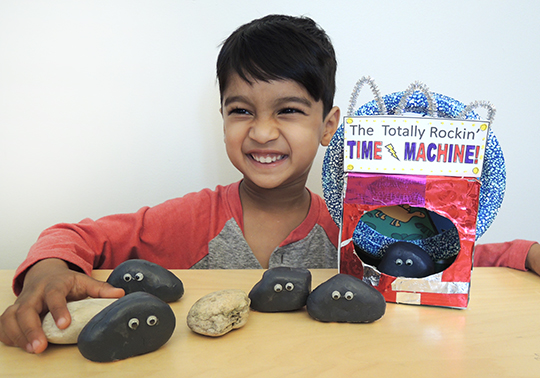
People might think rocks are totally boring and just sit there. But this book proves them all wrong! Turns out when it comes to eras, rocks win the time travel marathon, hands down! Why be sedentary when you can be…wait for it…sedimentary?
We read Old Rock (is not boring) by Deb Pilutti (G.P. Putnam’s Sons, 2020). Tall Pine, Spotted Beetle, and Hummingbird are convinced that Old Rock is boring. He doesn’t go anywhere, see anything, or do anything. But Old Rock explains how many millennia ago, he flew from a volcano, gazed at dinosaurs, rode a glacier, tumbled down a ridge, and watched a forest grow around him. It’s all about perspective!
You’ll need:
- 1 small tissue box
- 2 foam beads
- A short piece of bamboo skewer (ours was 5″)
- A 7″ paper plate
- One time travel wheel template, printed on 8.5″ x 11″ paper
- Tin foil
- 1 rock
- Box cutter, scissors, glue and tape for construction
- Markers for decorating
We loved the idea of time passing for Old Rock, so we created this simply time machine project! Begin by placing a small tissue box on its side. Use a box cutter to cut a 1″ wide space in the sides and top of the box (leave the bottom intact):
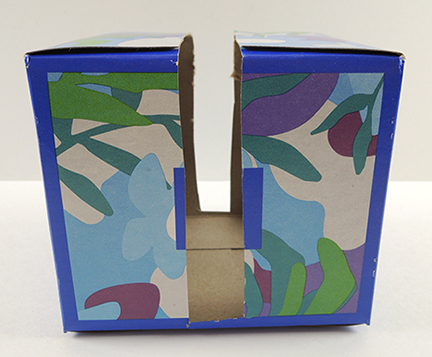
Next, glue a foam bead to the center top of the box. No foam bead handy? Use a small snippet of drinking straw instead. Repeat with a second bead on the opposite side of the box. The bamboo skewer should thread easily through them, creating an axle for your paper plate:
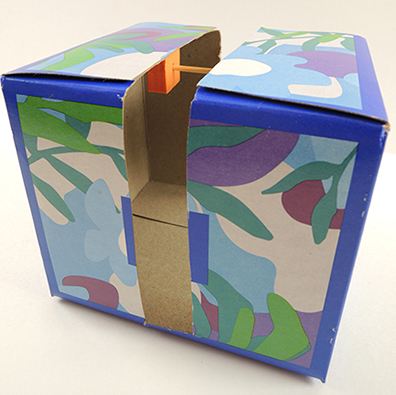
Now for your spinning time travel wheel! Cut the template from the paper and color. A special shout out summer intern, Malaysia for her volcano, dinosaur, and glacier artwork! You’ll notice the final panel on the template is blank. That’s where kids can draw their own homes.
 Use the bamboo skewer to poke a hole through the template and the paper plate. Thread the skewered plate through the foam beads to create your rotating time travel wheel like so:
Use the bamboo skewer to poke a hole through the template and the paper plate. Thread the skewered plate through the foam beads to create your rotating time travel wheel like so:
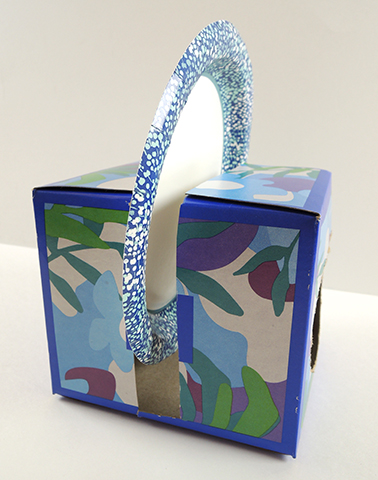 Decorate the outside of the box with tin foil (we offered embossed foil paper and sparkle stems as well). If you’d like the “Totally Rockin’ Time Machine” sign, here is the template. Make sure not to cover the open mouth of the tissue box open – that’s your time travel machine’s viewfinder. Finally…the rock!
Decorate the outside of the box with tin foil (we offered embossed foil paper and sparkle stems as well). If you’d like the “Totally Rockin’ Time Machine” sign, here is the template. Make sure not to cover the open mouth of the tissue box open – that’s your time travel machine’s viewfinder. Finally…the rock!
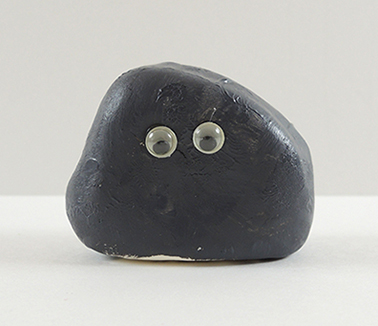
We didn’t have a supply of rocks handy, so we crafted these out of model magic. Just add grey craft paint and wiggle eyes and you have one very charismatic rock. Place the rock inside the time machine, spin the wheel, and watch the millennia fly by!
This book went over SO well at story time! It’s lovely, well-paced, and exciting. It’s no surprise it’s a multiple award-winner. The kids were absolutely riveted. But we were further delighted when, completely randomly, a youngster arrived with a couple rocks of his own! You can see them in the intro image, but we wanted to give his special rocks a portrait of their very own:
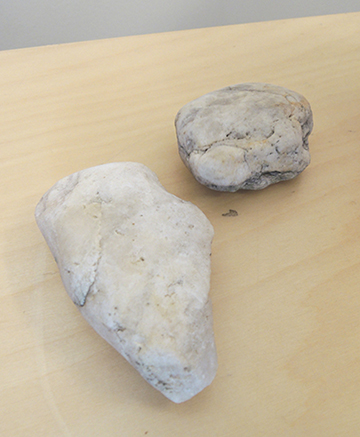

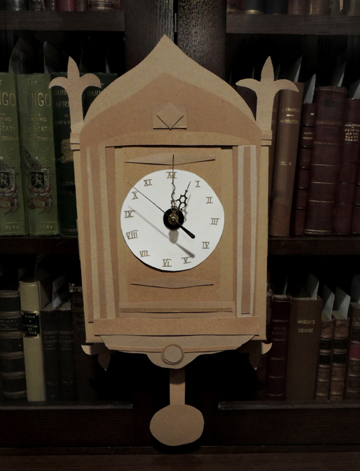
 At $8.50 a pop, they can get pricey, especially if you’re doing this project with multiple kids. However, you can find them for a couple bucks cheaper on Amazon. The important thing to keep in mind is the length of the motor’s shaft (i.e. the part that the clock hands slide on to). The shafts can range anywhere from .25″ to 1″. For this project, you want to aim for the shorter shafts. Otherwise, your clock hands will stick pretty far out of your cardboard clock base. Also pay attention to the lengths of the clock hands. You don’t want them to extend past the body of your clock.
At $8.50 a pop, they can get pricey, especially if you’re doing this project with multiple kids. However, you can find them for a couple bucks cheaper on Amazon. The important thing to keep in mind is the length of the motor’s shaft (i.e. the part that the clock hands slide on to). The shafts can range anywhere from .25″ to 1″. For this project, you want to aim for the shorter shafts. Otherwise, your clock hands will stick pretty far out of your cardboard clock base. Also pay attention to the lengths of the clock hands. You don’t want them to extend past the body of your clock.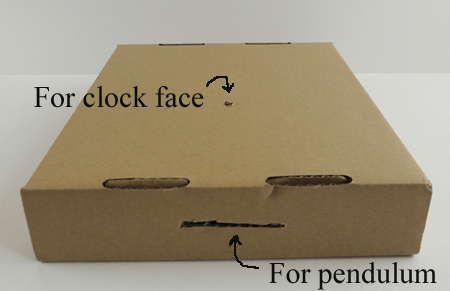 Next, place a piece of tagboard and a circle of white card stock over the hole, then redrill the hole. The circle is your clock face, and the tagboard piece elevates the clock face a little bit.
Next, place a piece of tagboard and a circle of white card stock over the hole, then redrill the hole. The circle is your clock face, and the tagboard piece elevates the clock face a little bit.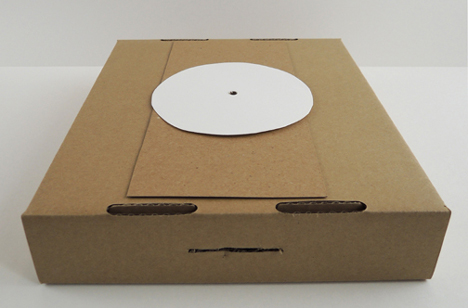 Before you glue the tagboard and the clock face to the lid, however, you’ll want to use markers to add numbers and decoration to your clock face. Check out these awesome clock faces. The smiling kitty!
Before you glue the tagboard and the clock face to the lid, however, you’ll want to use markers to add numbers and decoration to your clock face. Check out these awesome clock faces. The smiling kitty!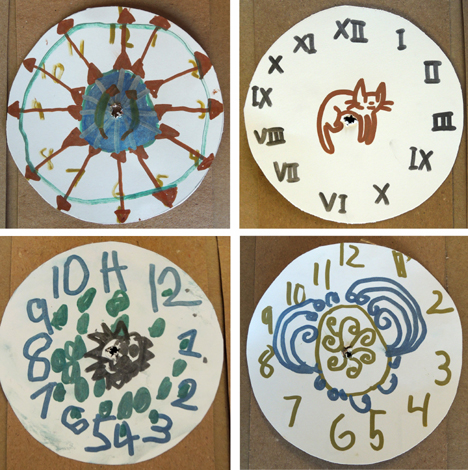 When your clock face is finished, glue it to your clock. Then start adding a bunch of tagboard flourishes. We cut a bunch of different shapes and styles of flourishes, and let the kids decide what they wanted to use on their clocks. The more layers and texture, the better it looks.
When your clock face is finished, glue it to your clock. Then start adding a bunch of tagboard flourishes. We cut a bunch of different shapes and styles of flourishes, and let the kids decide what they wanted to use on their clocks. The more layers and texture, the better it looks. You can also use markers to decorate the clock. We offered Crayola metallic markers, and the results were fantastic.
You can also use markers to decorate the clock. We offered Crayola metallic markers, and the results were fantastic.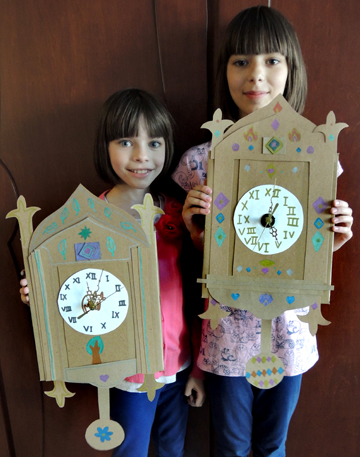 When all the decorating is done, install the clock movement. Just follow the instructions on the packaging, add a battery (a single AA), and you’re done!
When all the decorating is done, install the clock movement. Just follow the instructions on the packaging, add a battery (a single AA), and you’re done! Tap the pendulum to watch it swing back and forth. Eventually, it winds down and comes to a stop, but while it’s swinging, the illusion of a working clock is quite real!
Tap the pendulum to watch it swing back and forth. Eventually, it winds down and comes to a stop, but while it’s swinging, the illusion of a working clock is quite real!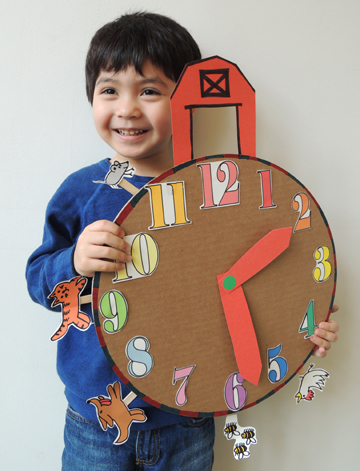 Go beyond Hickory Dickory Dock with this clever crank clock! Turn the handle on the back to send the characters dashing around the numbers and through the big red barn (scroll to the bottom of the post to see it in action)!
Go beyond Hickory Dickory Dock with this clever crank clock! Turn the handle on the back to send the characters dashing around the numbers and through the big red barn (scroll to the bottom of the post to see it in action)!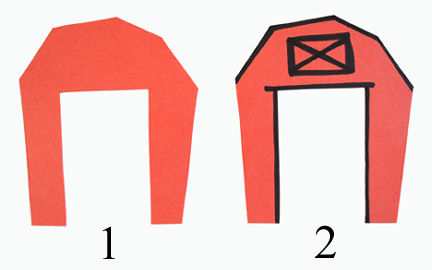 Attach the barn to the back of the clock face, right above the number 12. I highly recommend attaching the barn with hot glue. You really want the barn to stick because later, it can be used as a carrying handle for your clock! Here’s what the finished clock face looks like:
Attach the barn to the back of the clock face, right above the number 12. I highly recommend attaching the barn with hot glue. You really want the barn to stick because later, it can be used as a carrying handle for your clock! Here’s what the finished clock face looks like: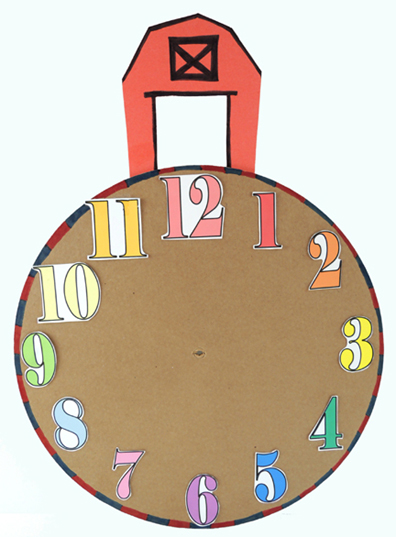 Set the finished clock face aside for a moment. Cut four, 1.5″ tabs in the end of a toilet paper tube. Then bend the tabs outward and hot glue the toilet paper tube to the back of the second cardboard circle:
Set the finished clock face aside for a moment. Cut four, 1.5″ tabs in the end of a toilet paper tube. Then bend the tabs outward and hot glue the toilet paper tube to the back of the second cardboard circle: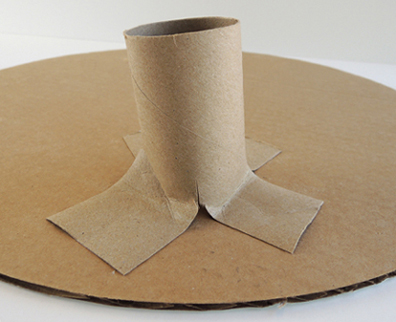 You’ll notice that the toilet paper handle gets glued on the perimeter of the cardboard circle. We experimented and found that was the best handle position for cranking the clock.
You’ll notice that the toilet paper handle gets glued on the perimeter of the cardboard circle. We experimented and found that was the best handle position for cranking the clock.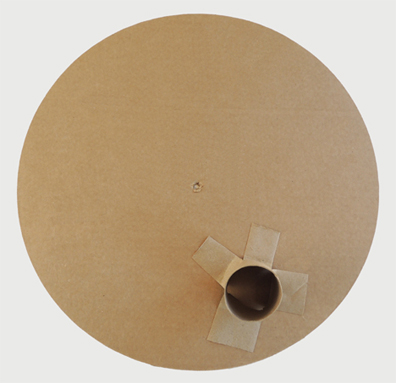 Cut and color the animals from the template, and tape (or glue) them onto the ends of the craft sticks. Make sure there’s plenty of room at the bottom of the craft sticks – you’ll need some space to attach the sticks to the clock.
Cut and color the animals from the template, and tape (or glue) them onto the ends of the craft sticks. Make sure there’s plenty of room at the bottom of the craft sticks – you’ll need some space to attach the sticks to the clock.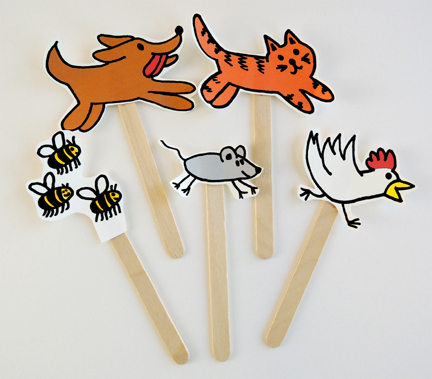 Tape the craft sticks to the cardboard circle. Note – the craft sticks need to be on the same side as the toilet paper tube handle. If the sticks are taped on the opposite side, they will rub and bump into your hand while you’re operating the clock. If you want to follow the order of the characters in the book, the mouse should go first, followed by the cat, dog, bees, and hen.
Tape the craft sticks to the cardboard circle. Note – the craft sticks need to be on the same side as the toilet paper tube handle. If the sticks are taped on the opposite side, they will rub and bump into your hand while you’re operating the clock. If you want to follow the order of the characters in the book, the mouse should go first, followed by the cat, dog, bees, and hen.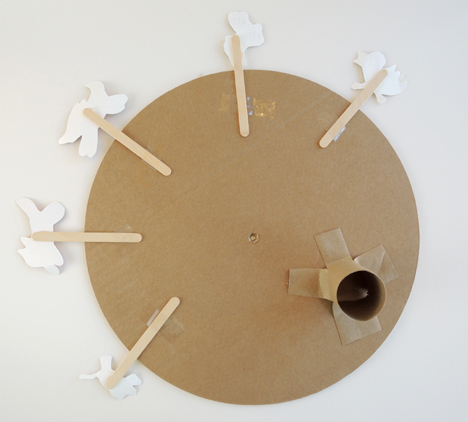 The back is done, time to put two clock circles together! Push a brass fastener through the clock face’s slit (you might need to enlarge the slit a little with a pair of scissors). Thread 2 foam beads on the fastener’s prongs:
The back is done, time to put two clock circles together! Push a brass fastener through the clock face’s slit (you might need to enlarge the slit a little with a pair of scissors). Thread 2 foam beads on the fastener’s prongs: Push the prongs through the second circle’s slit, then unfold the prongs and secure in place with tape. Depending on your cardboard, foam beads, and brass fastener, you might have to do a little adjusting to get the circles to rotate smoothly.
Push the prongs through the second circle’s slit, then unfold the prongs and secure in place with tape. Depending on your cardboard, foam beads, and brass fastener, you might have to do a little adjusting to get the circles to rotate smoothly.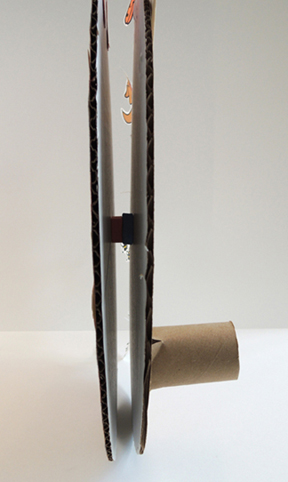
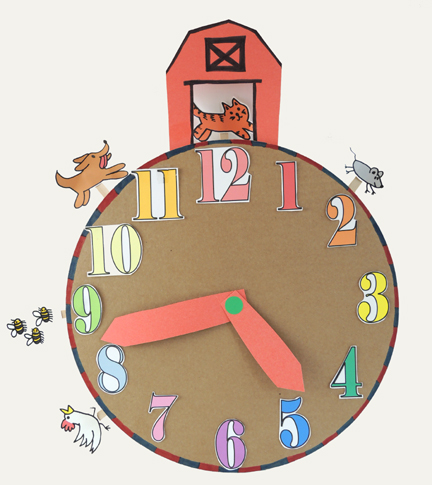 To operate the clock, grip the clock face firmly at the bottom. Use your other hand to crank the toilet paper tube handle. You might have to adjust the animals a little, or bend the clock hands upward a bit, if they snag on the barn door or the numbers. But eventually, you’ll have a smooth race around the clock!
To operate the clock, grip the clock face firmly at the bottom. Use your other hand to crank the toilet paper tube handle. You might have to adjust the animals a little, or bend the clock hands upward a bit, if they snag on the barn door or the numbers. But eventually, you’ll have a smooth race around the clock!